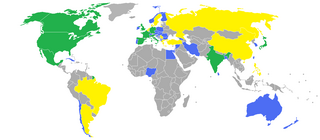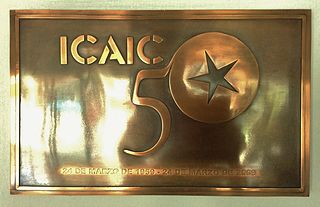Related Research Articles

A film festival is an organized, extended presentation of films in one or more cinemas or screening venues, usually in a single city or region. Increasingly, film festivals show some films outdoors. Films may be of recent date and depending upon the festival's focus, can include International and Domestic releases. Some film festivals focus on a specific filmmaker, genre of film, or subject matter. Several film festivals focus solely on presenting short films of a defined maximum length. Film festivals are typically annual events. Some film historians, including Jerry Beck, do not consider film festivals as official releases of the film.

Latin America is a collective region of the Americas where Romance languages—languages derived from Latin—are predominantly spoken. The term was coined in France in the mid-19th century to refer to regions in the Americas that were ruled by the Spanish, Portuguese, and French empires.

The Americas, sometimes collectively called America, are a landmass comprising the totality of North and South America. The Americas make up most of the land in Earth's Western Hemisphere and comprise the New World.

Luis Buñuel Portolés was a Spanish and Mexican filmmaker who worked in France, Mexico, and Spain. He has been widely considered by many film critics, historians, and directors to be one of the greatest and most influential filmmakers of all time. Buñuel’s works were known for their avant-garde surrealism which were also infused with political commentary.

Y tu mamá también is a 2001 Mexican road film directed by Alfonso Cuarón and co-written by him and his brother Carlos. It stars Mexican actors Diego Luna and Gael García Bernal and Spanish actress Maribel Verdú.

The cinema of the United States, consisting mainly of major film studios along with some independent films, has had a large effect on the global film industry since the early 20th century. The dominant style of American cinema is classical Hollywood cinema, which developed from 1910 to 1962 and is still typical of most films made there to this day. While Frenchmen Auguste and Louis Lumière are generally credited with the birth of modern cinema, American cinema soon came to be a dominant force in the emerging industry. With more than 600 English-language films released on average every year As of 2017, it produced the fourth-largest number of films of any national cinema, after India, Japan, and China. While the national cinemas of the United Kingdom, Canada, Australia, and New Zealand also produce films in the same language, they are not part of the Hollywood system. Because of this, Hollywood has also been considered a transnational cinema, and has produced multiple language versions of some titles, often in Spanish or French. Contemporary Hollywood often outsources production to the United Kingdom, Canada, Australia, and New Zealand. The major film studios of Hollywood are the primary source of the most commercially successful and most ticket-selling movies in the world.

Mexican cinema dates to the late nineteenth century during the rule of President Porfirio Díaz. Seeing a demonstration of short films in 1896, Díaz immediately saw the importance of documenting his presidency in order to present an ideal image of it. With the outbreak of the Mexican Revolution in 1910, Mexican and foreign makers of silent films seized the opportunity to document its leaders and events. From 1915 onward, Mexican cinema focused on narrative film.

María de los Dolores Asúnsolo y López Negrete, known professionally as Dolores del Río, was a Mexican actress. With a career spanning more than 50 years, she is regarded as the first major female Latin American crossover star in Hollywood. Along with a notable career in American cinema during the 1920s and 1930s, she was also considered one of the most important female figures in the Golden Age of Mexican cinema, and one of the most beautiful actresses of her era.
The film industry or motion picture industry comprises the technological and commercial institutions of filmmaking, i.e., film production companies, film studios, cinematography, animation, film production, screenwriting, pre-production, post-production, film festivals, distribution, and actors. Though the expense involved in making films almost immediately led film production to concentrate under the auspices of standing production companies, advances in affordable filmmaking equipment, as well as an expansion of opportunities to acquire investment capital from outside the film industry itself, have allowed independent film production to evolve.

World cinema is a term in film theory that refers to films made outside of the American motion picture industry, particularly those in opposition to the aesthetics and values of commercial American cinema. The Third Cinema of Latin America and various national cinemas are commonly identified as part of world cinema. The term has been criticized for Americentrism and for ignoring the diversity of different cinematic traditions around the world.
The Golden Age of Mexican Cinema is a boom period in the history of Mexican cinema, which began in 1936 with the premiere of the film Allá en el Rancho Grande, and culminated in 1956.
Latin American cinema refers collectively to the film output and film industries of Latin America. Latin American film is both rich and diverse, but the main centers of production have been Argentina, Brazil and Mexico. Latin American cinema flourished after the introduction of sound, which added a linguistic barrier to the export of Hollywood film south of the border.

National cinema is a term sometimes used in film theory and film criticism to describe the films associated with a specific nation-state. Although there is little relatively written on theories of national cinema it has an irrefutably important role in globalization. Film provides a unique window to other cultures, particularly where the output of a nation or region is high.

The cinema of Venezuela is the production and industry of filmmaking in Venezuela. Venezuelan cinema has been characterised from its outset as propaganda, partially state-controlled and state-funded, commercial cinema. The nation has seen a variety of successful films, which have reaped several international awards. Still, in terms of quality, it is said that though "we can point to specific people who have made great films in Venezuela [and] a couple of great moments in the history of Venezuelan cinema, [...] those have been exceptions". In the 21st century, Venezuelan cinema has seen more independence from the government, but has still been described as recently as 2017 to be at least "influenced" by the state.

María Novaro is a Mexican film director. She was among the first generation of female filmmakers to graduate from a film school in Mexico. She has made five feature films and fourteen short films. Within the Mexican film industry, she has been a cinematographer, sound mixer, director, screenwriter and editor. Today, Novaro is one of the best known Mexican filmmakers to come out of the New Mexican Cinema and her films express Millian's idea of cinema in feminine.

The Instituto Cubano del Arte e Industria Cinematográficos was established by the Cuban government in March 1959 after the Cuban Revolution. Its prominent members are Sara Gómez, Tomás Gutiérrez Alea, Julio García Espinosa, Alfredo Guevara and Santiago Álvarez.
Latin American nations have been producing national LGBT+ cinema since at least the 1980s, though homosexual characters have been appearing in their films since at least 1923.:75 The collection of LGBT-themed films from 2000 onwards has been dubbed New Maricón Cinema by Vinodh Venkatesh; the term both includes Latine culture and identity and does not exclude non-queer LGBT+ films like Azul y no tan rosa.:6-7 Latin American cinema is largely non-systemic, which is established as a reason for its wide variety of LGBT-themed films.:142

Latin music is a term used by the music industry as a catch-all category for various styles of music from Ibero-America, which encompasses Latin America, Spain, Portugal, and the Latino population in Canada and the United States, as well as music that is sung in either Spanish and/or Portuguese.
The Havana Film Festival New York (HFFNY) is a film festival, based in New York City, that screens cinema from across Latin America with a special focus on Cuba and its film industry. It is a project of The American Friends of the Ludwig Foundation of Cuba, a 501(c)(3) tax-exempt organization with the mission of building cultural bridges between the United States and Cuba through arts projects.
References
- ↑ Mexican Cinema: A Panoramic View, Manuel Michel and Neal Oxenhandler, Film Quarterly18, #4 (Summer 1965), pp. 46–55.
- ↑ p. 28, Mexican National Cinema, Andrea Noble, London, New York: Routledge, 2005. ISBN 0-415-23010-1.
- ↑ Magical Reels: A History of Cinema in Latin America, John King, London, New York: Verso, 2000. ISBN 1-85984-233-X.